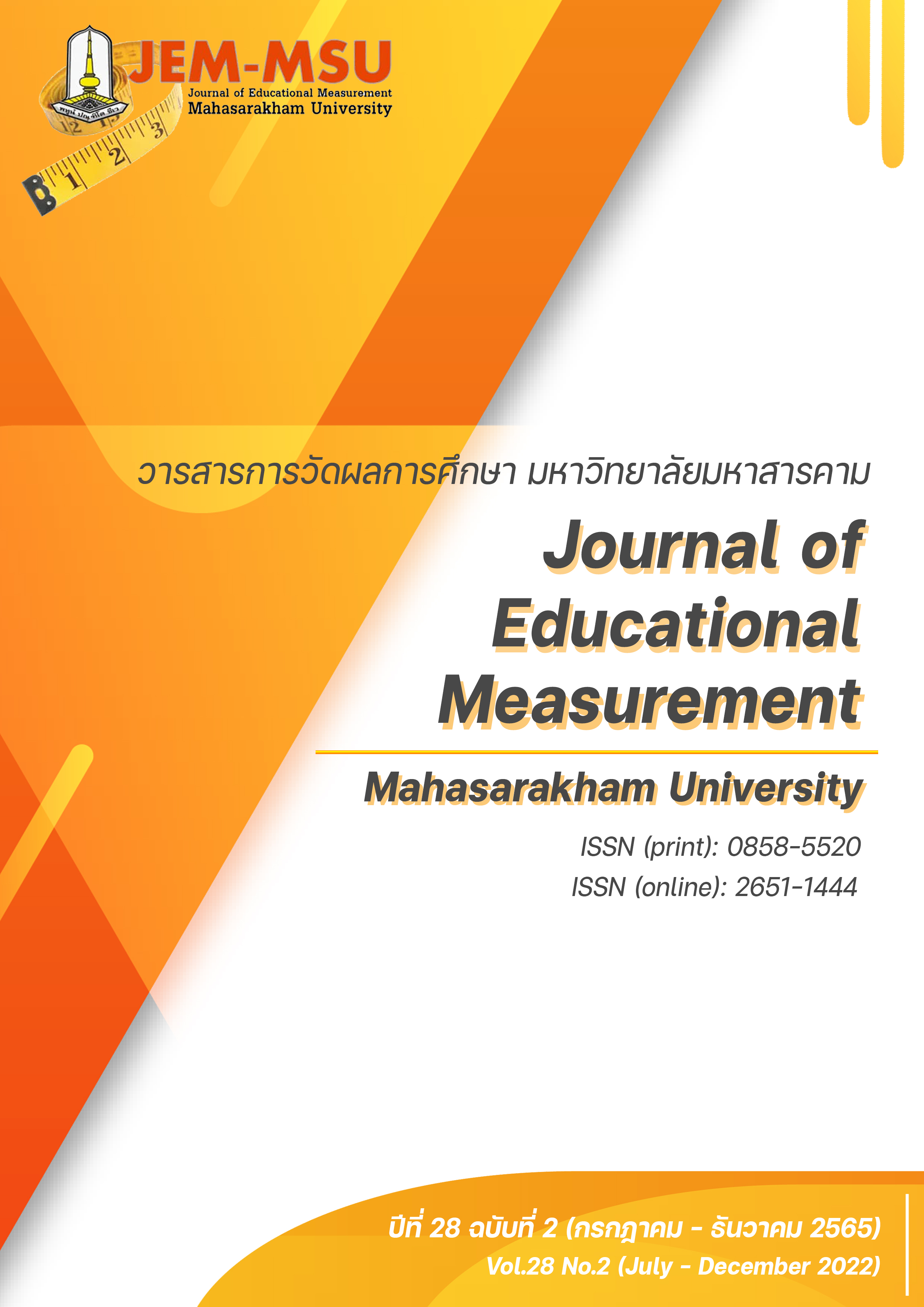การพัฒนาโมเดลความสัมพันธ์เชิงสาเหตุของการคิดเชิงอนาคต สำหรับนักเรียนระดับชั้นมัธยมศึกษาปีที่ 3 จังหวัดศรีสะเกษ
Main Article Content
บทคัดย่อ
การวิจัยครั้งนี้มีความมุ่งหมายเพื่อ 1) เพื่อศึกษาและพัฒนาโมเดลความสัมพันธ์เชิงสาเหตุของตัวแปร ที่มีอิทธิพลต่อการคิดเชิงอนาคตของนักเรียนระดับชั้นมัธยมศึกษาปีที่ 3 และ 2) เพื่อศึกษาแนวทางการส่งเสริมการคิดเชิงอนาคตของนักเรียนระดับชั้นมัธยมศึกษาปีที่ 3 กลุ่มตัวอย่างแบ่งออกเป็น 2 ระยะ คือ ระยะที่ 1 กิจกรรมที่ 1 เป็นนักเรียนชั้นมัธยมศึกษาปีที่ 3 จำนวน 8 คน ผู้เชี่ยวชาญด้านการคิด จำนวน 3 คน โดยการเลือกแบบเจาะจง (purposive sampling) กิจกรรมที่ 2 เป็นนักเรียนชั้นมัธยมศึกษาปีที่ 3 จังหวัดศรีสะเกษ ภาคเรียนที่ 2 ปีการศึกษา 2563 จาก 12 โรงเรียน จำนวน 860 คน ได้มาโดยการสุ่มแบบหลายขั้นตอน (multi-stage random sampling) ระยะที่ 2 เป็นนักเรียนชั้นมัธยมศึกษาปีที่ 3 จำนวน 8 คน ผู้เชี่ยวชาญด้านการคิด จำนวน 3 คน โดยการเลือกแบบเจาะจง (purposive sampling) เครื่องมือที่ใช้ในการวิจัย ระยะที่ 1 ประกอบด้วย 1) แบบสัมภาษณ์ชนิดมีโครงสร้าง เพื่อหาปัจจัยที่มีอิทธิพลต่อการคิดเชิงอนาคตของนักเรียน 2) แบบสอบถามปัจจัยที่มีอิทธิพลต่อการคิดเชิงอนาคตและแบบวัดการคิดเชิงอนาคตของนักเรียน ระยะที่ 2 เครื่องมือที่ใช้ คือ แบบสัมภาษณ์ชนิดมีโครงสร้าง เพื่อหาแนวทางการส่งเสริมการคิดเชิงอนาคตของนักเรียน วิเคราะห์ข้อมูลโดยใช้สถิติเชิงพรรณนา การวิเคราะห์สหสัมพันธ์อย่างง่าย และวิเคราะห์ข้อมูลโดยใช้สถิติเชิงอ้างอิงเพื่อทดสอบสมการโครงสร้างเชิงเส้น
ผลการวิจัยปรากฏดังนี้
1) โมเดลความสัมพันธ์เชิงสาเหตุของการคิดเชิงอนาคตที่พัฒนาขึ้นมีความสอดคล้องกลมกลืนกับข้อมูลเชิงประจักษ์ โดยพบว่า ปัจจัยที่มีอิทธิพลทางตรงต่อการคิดเชิงอนาคต คือ ความฉลาดทางอารมณ์ บุคลิกภาพ การกำกับตนเอง เจตคติต่อการเรียน และการอบรมเลี้ยงดูแบบประชาธิปไตย ปัจจัยที่มีอิทธิพลทางอ้อมต่อการคิดเชิงอนาคต คือ บุคลิกภาพ การอบรมเลี้ยงดูแบบประชาธิปไตย การกำกับตนเอง แรงจูงใจ ใฝ่สัมฤทธิ์ และเจตคติต่อการเรียน
2) แนวทางการส่งเสริมการคิดเชิงอนาคตของนักเรียน สรุปผลได้ดังนี้ ส่งเสริมนักเรียนให้ฝึกคิดเป็น เชิงระบบและจัดกิจกรรมการเรียนการสอนที่หลากหลายเน้นการทำกิจกรรมร่วมกันเป็นทีม ให้นักเรียนได้เรียนรู้จากประสบการณ์ตรง ครูสร้างความตระหนักในการเรียนรู้ของนักเรียนทั้งในและนอกห้องเรียน ปฏิบัติตนเป็นแบบอย่างที่ดี โรงเรียนจัดกิจกรรมที่หลากหลายให้นักเรียนได้แสดงออกอย่างสร้างสรรค์ ผู้ปกครองพูดคุยทำความเข้าใจให้กำลังใจในการเรียนให้โอกาสตัดสินใจด้วยตัวเองอย่างมีเหตุผล
Article Details

This work is licensed under a Creative Commons Attribution-NonCommercial-NoDerivatives 4.0 International License.
เนื้อหาและข้อมูลในบทความที่ลงตีพิมพ์ในวารสารการวัดผลการศึกษา มหาวิทยาลัยมหาสารคาม ถือเป็นข้อคิดเห็นและความรับผิดชอบของผู้เขียนบทความโดยตรง ซึ่งกองบรรณาธิการวารสาร ไม่จำเป็นต้องเห็นด้วย หรือร่วมรับผิดชอบใดๆ
บทความ ข้อมูล เนื้อหา รูปภาพ ฯลฯ ที่ได้รับการตีพิมพ์ในวารสารการวัดผลการศึกษา มหาวิทยาลัยมหาสารคาม ถือเป็นลิขสิทธิ์ของวารสารการวัดผลการศึกษา มหาวิทยาลัยมหาสารคาม หากบุคคลหรือหน่วยงานใดต้องการนำทั้งหมดหรือส่วนใดส่วนหนึ่งไปเผยแพร่ต่อหรือกระทำการใดๆ จะต้องได้รับอนุญาตเป็นลายลักษณ์อักษรจากวารสารการวัดผลการศึกษา มหาวิทยาลัยมหาสารคาม ก่อนเท่านั้น
References
Chaiwongsa, A. (2005). A Study of the Characteristics of Future Thinkers of Grade 5 Students (Lamphun) [Master's thesis]. Srinakharinwirot University. (in Thai).
Charoenwongsak, K (2020). Future thinking (7th ed.). Success Media. (in Thai).
Chuenchit, J. (2007). Factors affecting future prospects of undergraduate students in the field of study. Faculty of Physical Education Recreation Srinakharinwirot University [Master's thesis]. Srinakharinwirot University. (in Thai).
Dumrongpanich, S. (2020). Mplus program and data analysis in behavioral science and Social Sciences. Chulalongkorn University Press. (in Thai).
Kham-ara, N. (2007). The relationship between some factors affecting the characteristics of future thinkers. of students in the 3rd grade Schools in United Campus Benchasiri Educational Service Area Office Bangkok District 1 [Master's thesis]. Srinakharinwirot University. (in Thai).
Khot-asa, K. (2016). The causal relationship model of futuristic thinking for students at grade level. high school Ubon Ratchathani Province [Master’ thesis]. Ubon Ratchathani Rajabhat University. (in Thai).
Kongkrob, S. (2015). Causal factors influencing future-oriented characteristics of Grade 3 students. Under the Office of Secondary Education Service Area, Region 27 (Roi-Et) [Master's Thesis]. Mahasarakham University. (in Thai).
Ministry of Education, (2010). National Education Act 1999 and its amendments (No. 2) B.E. 2002 and (No. 3) B.E. 2010. Express Transportation Organization of Thailand. (in Thai)
Munkham, S. (2016). Strategies for Teaching Strategic Thinking (5th ed.). Duangkamon Samai. (in Thai).
Office of the National Economic and Social Development Board. (2020). Economic Development Plan and National Society, Vol. 12 (2017-2021). Office of the Prime Minister. (in Thai).
Rungthanasak, H. (2009). Development of a causal relationship model towards future-oriented characteristics of students. Secondary school year 6 of schools under the Sisaket Educational Service Area Office, District 4 [Master's thesis]. Mahasarakham University. (in Thai).
Thongsawangjaeng, W. (2006). Development of a causal relationship model of future-oriented characteristics and Perseverance in studying of high school students Schools under the Office of the Eastern Basic Education Commission (Chonburi, Chachoengsao, Rayong, Nakhon Nayok) [Master's thesis]. Burapha University. (in Thai).
Wandee, W. (2011). Composition analysis of characteristics of future thinkers of students in Junior high school Component Analysis of Futuristic Thinker's Characteristics junior high school Under the Chiang Rai Educational Service Area Office, Region 4 [Master's thesis]. Chiang Rai Rajabhat University. (in Thai).
Worachet, K. (2005). A Study of the Relationship of Causal Factors Affecting Future-oriented Characteristics of Mathayomsuksa 3 Buriram Province [Master’ thesis]. Srinakharinwirot University. (in Thai).

